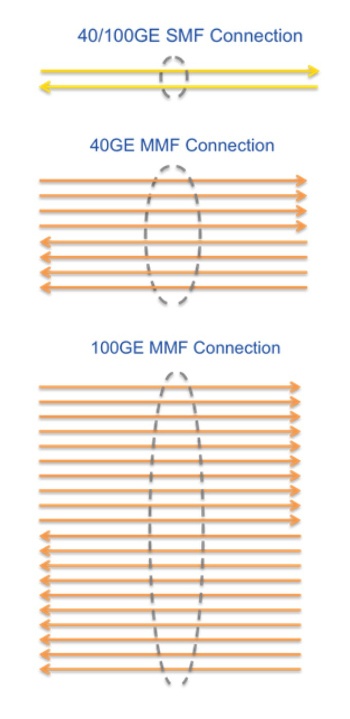While many enterprises are considering the move to a 40/100G ethernet infrastructure, often they overlook the impact of remaining with a multimode fiber infrastructure. While there is little difference in the infrastructure requirements of 10G ethernet for single-mode fiber and multimode fiber infrastructures, there is an exponential difference in 40/100G ethernet infrastructures. Many people tout the economics of MMF vs SMF lasers as the key reason for remaining with their MMF infrastructure; however, the savings achieved there will likely be erased by the increased cost of the passive optical infrastructure.
For example, many companies tap their optical fibers to monitor traffic. For 10GE, this was simple regardless of the fiber type – there was one tap (2 splitters for 2 fiber duplex communications) per connection. For SMF 40/100GE, this does not change. In fact the same infrastructure can usually be used. However, for MMF 40/100GE you must plan for an entirely new infrastructure because there are 8-20 fibers per connection, which means a single bidirectional, passive optical tap requires 8-20 splitters. This likely will result in $1000-$2500 in extra costs for the additional splitters. In addition, all of the patch panels must be replaced with MTP connectorized patch panels to terminate the associated 8-20 fiber cables, further increasing costs.
Figure 1: Number of Fibers Per Connection for 40/100G Ethernet SMF & MMF

If the cost isn’t enough to consider moving these connections to SMF, consider the loss constraints on 40/100GE MMF. Due to the higher bandwidth more attenuation is incurred resulting in smaller optical power budgets to accommodate splitter, splice, and fiber losses. With 40/100GE loss budgets around 1.5dB, it is impossible to insert passive optics to monitor these links. If SMF is used the link loss budget is substantially higher (distance dependent of course), so tapping these optical signals for monitoring is virtually the same as it is for 10GE today.
Want to Learn More?
With a special focus on developing and offering customized solutions for 40G, 100G, and network monitoring applications, the M2 team is always available to support your efforts. Contact us today and let our experienced team help you to meet your optical networking objectives.





